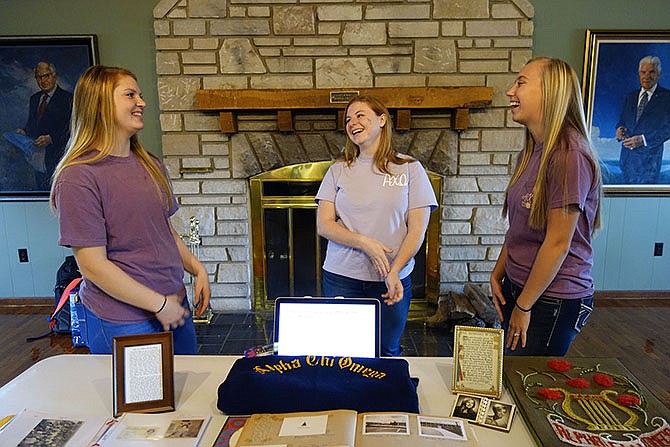Back in the Dark Ages - the 1960s - William Woods University was an all-female college with restrictive rules and ideas foreign to young women today.
"These were just funny," student Grace Wade said, pointing at a list of possible majors on a display she put together with her classmates Jennifer Anton and Megan Rogers.
The list includes majors in home economics, secretarial sciences, homemaking and even air hostess.
"We looked up old student handbooks from the 1960s," Wade said of their history project, included in a Thursday event, "The Woods and Fulton in the '60s."
The project was led by new college history professor Craig Bruce Smith, with students picking topics, researching them and drawing conclusions, then exhibiting the information. Topics included sororities, Brick District history, the Fulton State Hospital and more.
"Students had to have their parents' permission to do almost anything," Wade said, adding dress was much different (skirts, dresses, nylons and sensible shoes).
Automobiles were forbidden for some students, and no one was allowed to leave campus without clearing it first.
Smith said the project began in August, and students were self driven.
"Students went to the historical society and through old yearbooks and did interviews with people who went to school here in the 1960s," said Smith, who joined the college staff in August. "They did all their own research. This was all about teaching them how to do their own research and come to their own conclusions."
Smith's 20 students involved in the project paired into teams and chose their topics.
"We started working on this in August," he said.
Three students did a project about Fulton's downtown Brick District, and in particular, focused on a former eatery, "The Spot" once located behind the Red Cross Pharmacy on the northwest corner of Sixth and Market streets. Parker Wilkinson, Connor Pearson and Ethan O'Keefe said they worked with the Kingdom of Callaway Historical Society to delve into this history.
"We worked with the historical society to put together a picture of what Court Street looked like in 1960," Pearson said. "During our research, we found out the Spot Cafe is where everyone hung out."
People hung out there for good reason. A T-bone steak was $1.35, a hamburger steak was 75 cents and a quarter would buy a gal a real milkshake.
"We have some historical photos from the era," Pearson said. "It was a really fun project."
The students also discovered the building now housing Brooklyn Pizza, on the northwest corner of Court and Fifth streets, is the oldest downtown structure and was designed by Morris Frederick Bell.
"He had quite a few major projects," O'Keefe said.
That list included the Missouri School for the Deaf, the Fulton State Hospital and First Christian Church, plus campus buildings at both William Woods and Westminster College.
"So he was very significant to the area," O'Keefe added.
Alpha Chi Omega sorority sisters Maddie VanGuilder, Emily Gast and Shelby Feltrup studied the history of sororities at WWU. They asked for help from a 1960s sorority member, Judy Kuergeleis Schmuck, and hit a bonanza.
"She came with all this stuff," Gast said, pointing at a sorority blanket, a crocheted wall hanging, badges and a scrapbook.
"To earn your badge, you had to make a scrapbook," Gast added.
There was also hazing, now strictly forbidden.
"Now we're more open," Gast said. "Everybody's considered equal."
In 1960, there were three sororities, and of course, no fraternities. Today's WWU has four sororities and three fraternities. Classes then, as they are now, are still often shared between students of both colleges in Fulton.
Students said the project opened their eyes.
"It's funny how things change, but how they stay the same," Pearson said.
"It was fun learning about The Spot," Wilkinson added. "We would have gone there."
O'Keefe added another perspective.
"Fulton's insulated, but not immune to the trends of the time," he said. "It's interesting to see how it played out."

